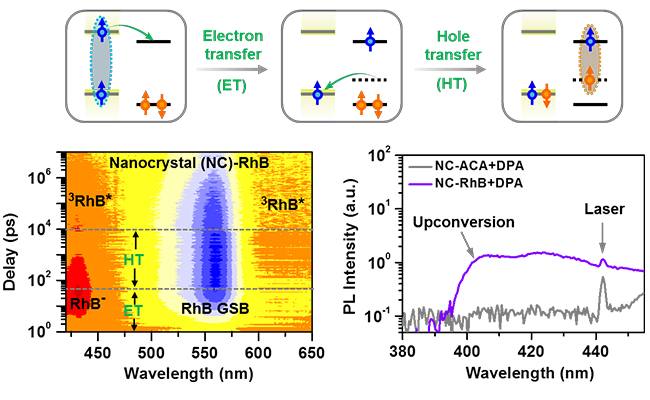Triplet energy transfer from colloidal nanocrystals is a novel approach to sensitizing molecular triplets. Recent studies suggest that triplet transfer can be mediated by a hole transfer process when it is energetically allowed.
However, electron-transfer-mediated triplet transfer has not been observed yet. It is probably due to that the hole-trapping in typical II-VI group nanocrystals inhibits the hole transfer step and the following initial electron transfer, hence disrupting a complete triplet exciton transfer.
Recently, a research group led by Prof. WU Kaifeng from the Dalian Institute of Chemical Physics (DICP) of the Chinese Academy of Sciences (CAS) observed the mechanisms for triplet energy migration across the inorganic/organic interface. They revealed a new mechanism called electron transfer-mediated triplet energy migration.
The results were published in J. Am. Chem. Soc. on June 1.

Electron transfer-mediated triplet energy migration from semiconductor nanocrystals to surface-anchored molecular acceptors(Image by LUO Xiao)
The scientists observed electron-transfer-mediated triplet energy transfer from CsPbCl3 and CsPbBr3 perovskite nanocrystals to surface-anchored Rhodamine molecules, and establised the mechanism by ultrafast spectroscopy.
The control experiments using CdS nanocrystals also confirmed the role of hole-trapping in inhibiting this mechanism.
The sensitized Rhodamine triplets engaged in a variety of applications such as photon upconversion and singlet oxygen generation.
“Compared to conventional one-step triplet transfer, this new sensitization mechanism is less demanding in terms of interfacial electronic coupling and hence is more generally implementable” said prof. WU.
This study not only establishes a complete framework of triplet energy transfer across nanocrystal/molecule interfaces, but also greatly expands the scope of molecular triplet sensitization using nanocrystals.
The research was supported by the National Natural Science Foundation of China, the Ministry of Science and Technology of China, the Chinese Academy of Sciences, and the LiaoNing Revitalization Talents Program. (Text by LUO Xiao).